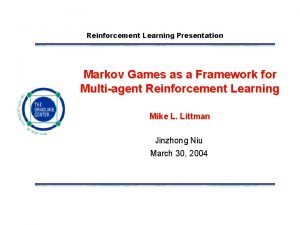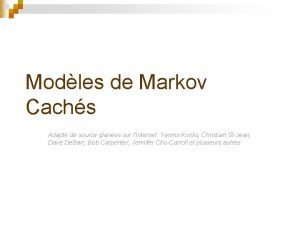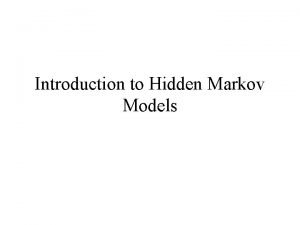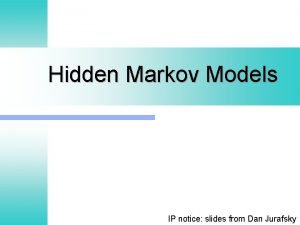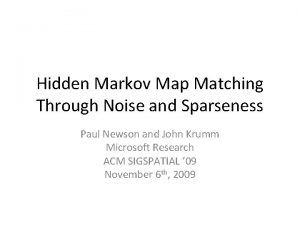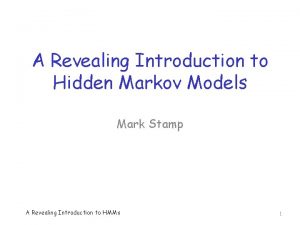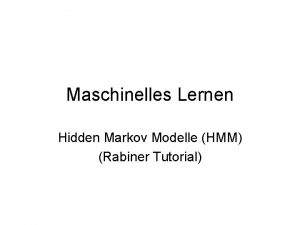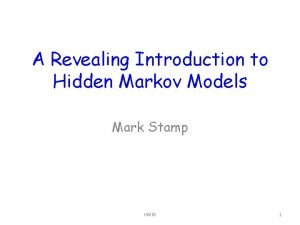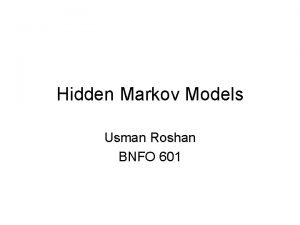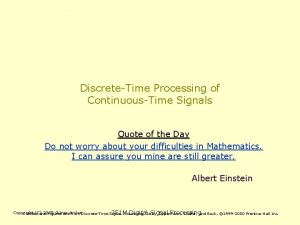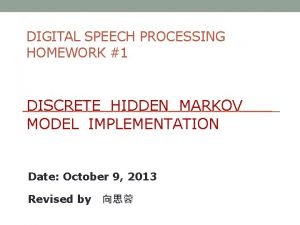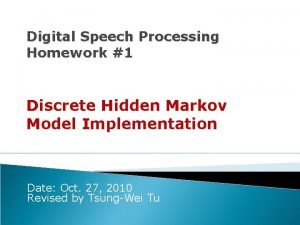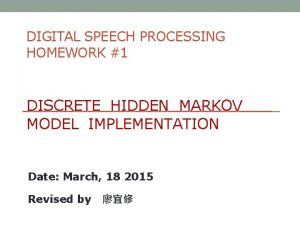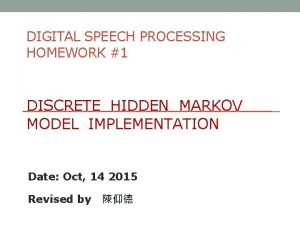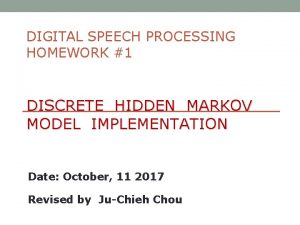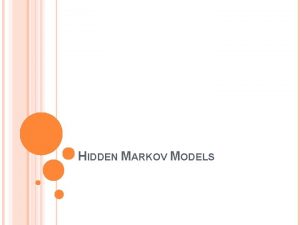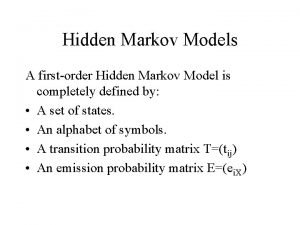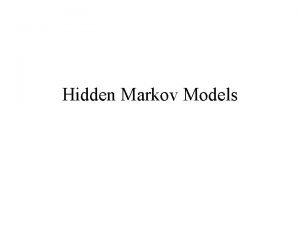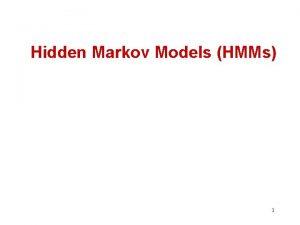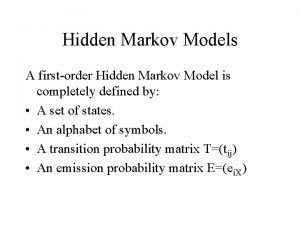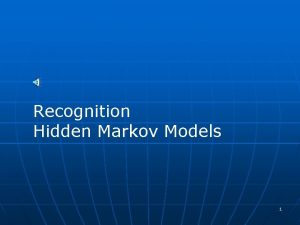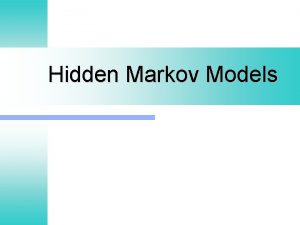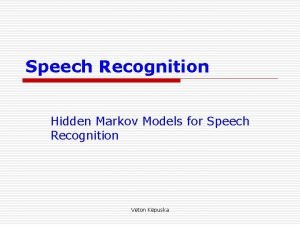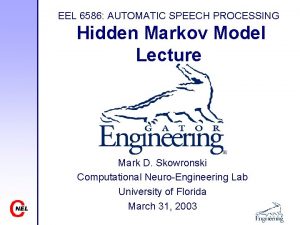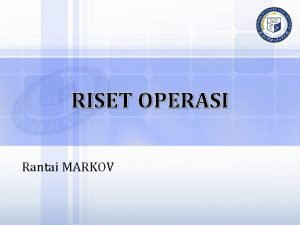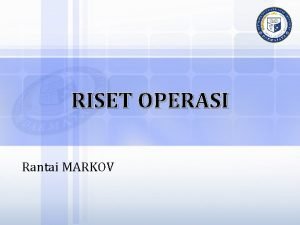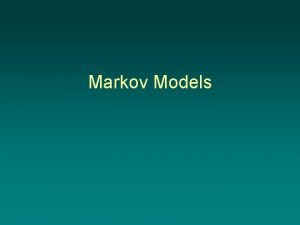DIGITAL SPEECH PROCESSING HOMEWORK 1 DISCRETE HIDDEN MARKOV































![32 Submit Requirement Compress your hw 1 into “hw 1_[學號]. zip” +- hw 1_[學號]/ 32 Submit Requirement Compress your hw 1 into “hw 1_[學號]. zip” +- hw 1_[學號]/](https://slidetodoc.com/presentation_image/190f30b21f17f8adf07db3fe7a99d565/image-32.jpg)



- Slides: 35

DIGITAL SPEECH PROCESSING HOMEWORK #1 DISCRETE HIDDEN MARKOV MODEL IMPLEMENTATION Date: October, 12 2016 Revised by 李致緯

2 Outline HMM in Speech Recognition Problems of HMM ◦ Training ◦ Testing File Format Submit Requirement

3 HMM IN SPEECH RECOGNITION

4 Speech Recognition • In acoustic model, • each word consists of syllables • each syllable consists of phonemes • each phoneme consists of some (hypothetical) states. “青色” → “青(ㄑㄧㄥ)色(ㄙㄜ、)” → ”ㄑ” → {s 1, s 2, …} • Each phoneme can be described by a HMM (acoustic model). • Each time frame, with an observance (MFCC vector) mapped to a state.

5 Speech Recognition • Hence, there are state transition probabilities ( aij ) and observation distribution ( bj [ ot ] ) in each phoneme acoustic model. • Usually in speech recognition we restrict the HMM to be a left-to-right model, and the observation distribution are assumed to be a continuous Gaussian mixture model.

6 Review • left-to-right • observation distribution are a continuous Gaussian mixture model

7 General Discrete HMM • aij = P ( qt+1 = j | qt = i ) t, i, j. bj ( A ) = P ( ot = A | qt = j ) t, A, j. Given qt , the probability distributions of qt+1 and ot are completely determined. (independent of other states or observation)

8 HW 1 v. s. Speech Recognition Homework #1 Speech Recognition set 5 Models Initial-Final model_01~05 “ㄑ” {ot } A, B, C, D, E, F 39 dim MFCC unit an alphabet a time frame observation sequence voice wave

9 HOMEWORK OF HMM

10 Flowchart testing_data. txt model_init. txt model_01. txt seq_model_ 01~05. txt train . . model_05. txt test CER testing_answer. txt

11 Problems of HMM • Training • Basic Problem 3 in Lecture 4. 0 • Give O and an initial model = (A, B, ), adjust to maximize P(O| ) i = P( q 1 = i ) , Aij = aij , Bjt = bj [ot] • Baum-Welch algorithm • Testing • Basic Problem 2 in Lecture 4. 0 • Given model and O, find the best state sequences to maximize P(O| , q). • Viterbi algorithm

12 Training Basic Problem 3: ◦ Give O and an initial model = (A, B, ), adjust to maximize P(O| ) i = P( q 1 = i ) , Aij = aij , Bjt = bj [ot] Baum-Welch algorithm A generalized expectation-maximization (EM) algorithm. 1. Calculate α (forward probabilities) and β (backward probabilities) by the observations. Find ε and γ from α and β Recalculate parameters ’ = ( A’ , B’ , ’ ) 2. 3. http: //en. wikipedia. org/wiki/Baum-Welch_algorithm

13 Forward Procedure αt+1(j) j i αt(i) t t+1 Forward Algorithm

14 Forward Procedure by matrix • Calculate β by backward procedure is similar.

15 Calculate γ N * T matrix

16 Calculate ε The probability of transition from state i to state j given observation and model. Totally (T-1) N*N matrices.

17 Accumulate ε and γ

18 Re-estimate Model Parameters ’ = ( A’ , B’ , ’ ) Accumulate ε and γ through all samples!! Not just all observations in one sample!!

19 Testing • Basic Problem 2: • Given model and O, find the best state sequences to maximize P(O| , q). • Calculate P(O| ) ≒ max P(O| , q) for each of the five models. • The model with the highest probability for the most probable path usually also has the highest probability for all possible paths.

20 Viterbi Algorithm http: //en. wikipedia. org/wiki/Viterbi_algorithm

21 Flowchart testing_data. txt model_init. txt model_01. txt seq_model_ 01~05. txt train . . model_05. txt test CER testing_answer. txt

22 FILE FORMAT

23 C or C++ snapshot

24 Input and Output of your programs Training algorithm ◦ input number of iterations initial model (model_init. txt) observed sequences (seq_model_01~05. txt) ◦ output =( A, B, ) for 5 trained models 5 files of parameters for 5 models (model_01~05. txt) Testing algorithm ◦ input trained models in the previous step modellist. txt (file saving model name) Observed sequences (testing_data 1. txt & testing_data 2. txt) ◦ output best answer labels and P(O| ) (result 1. txt & result 2. txt) Accuracy for result 1. txt v. s. testing_answer. txt

25 Program Format Example. /train iteration model_init. txt seq_model_01. txt. /test modellist. txt testing_data. txt result. txt

26 Input Files +- dsp_hw 1/ +- c_cpp/ | ++- modellist. txt //the list of models to be trained +- model_init. txt //HMM initial models +- seq_model_01~05. txt //training data observation +- testing_data 1. txt //testing data observation +- testing_answer. txt //answer for “testing_data 1. txt” +- testing_data 2. txt //testing data without answer

27 Observation Sequence Format seq_model_01~05. txt / testing_data 1. txt ACCDDDDFFCCCCBCFFFCCCCCEDADCCAEFCCCACDDFFCCD CABACCAFCCFFCCCDFFCCCCCDFFCDDDDFCDDCCFCCCEFFCCCCBC ABACCCDDDDFBCCCCCDDAACFBCCBCCCCCCCFFFCCCCCDBF AAABBBCCFFBDCDDFFACDCDFCDDFFFFFCDFFFCCCDCFFFFCCCCD AACCDCCCCCCCDCEDCBFFFCDCDCDAFBCDCFFCCDCCCEACDBAFFF CBCCCCDCFFCCCFFFFFBCCACCDCFCBCDDDCDCCDDBAADCCBFFCC CABCAFFFCCADCDCDDFCDFFCDDFFFCCCDDFCACCCCDCDFFCCAFF BAFFFFFFFCCCCDDDFFCCACACCCDDDFFFCBDDCBEADDCCDDACCF BACFFCCACEDCFCCEFCCCFCBDDDDFFFCCDDDFCCCDCCCADFCCBB ……

Model Format • model parameters. (model_init. txt /model_01~05. txt ) 0 1 2 3 4 5 initial: 6 0. 22805 0. 02915 0. 12379 0. 18420 0. 00000 0. 43481 0 1 2 3 4 5 transition: 6 0. 36670 0. 51269 0. 17125 0. 53161 0. 31537 0. 08201 0. 24777 0. 06364 0. 09149 0. 05842 0. 29564 0. 06203 0. 08114 0. 26536 0. 06787 0. 06607 0. 00141 0. 00153 0. 00217 0. 02538 0. 49395 0. 48348 0. 00303 0. 00017 A B C D E F observation: 6 0. 34292 0. 55389 0. 08053 0. 16186 0. 13727 0. 10949 0. 45833 0. 19536 0. 00147 0. 00072 0. 00000 0. 18097 0. 42137 0. 28189 0. 01585 0. 12113 0. 00001 0. 06694 0. 01863 0. 09414 0. 02412 0. 09857 0. 06969 0. 15020 0. 12050 0. 37143 0. 01016 0. 07078 0. 36145 0. 76911 0. 02559 0. 07438 0. 00001 0. 68433 0. 04579 0. 02003 0. 01727 0. 00068 0. 00572 0. 00913 0. 03167 0. 01540 0. 12364 0. 59082 0. 25483 0. 38311 0. 25753 Prob( q 1=3|HMM) = 0. 18420 Prob(qt+1=4|qt=2, HMM) = 0. 00913 Prob(ot=B|qt=3, HMM) = 0. 02412 2 8

29 Model List Format • Model list: modellist. txt testing_answer. txt model_01. txt model_02. txt model_03. txt model_04. txt model_05. txt model_01. txt model_02. txt model_04. txt model_03. txt model_05. txt model_04. txt …….

30 Testing Output Format • result. txt • Hypothesis model and it likelihood model_01. txt model_05. txt model_03. txt ……. 1. 0004988 e-40 6. 3458389 e-34 1. 6022463 e-41 • acc. txt • Calculate the classification accuracy. • ex. 0. 8566 • Only the highest accuracy!!! • Only number!!!

31 Submit Requirement Upload to CEIBA Your program ◦ train. c, test. c, Makefile Your 5 Models After Training ◦ model_01~05. txt Testing result and accuracy ◦ result 1~2. txt (for testing_data 1~2. txt) ◦ acc. txt (for testing_data 1. txt) Document (pdf) (No more than 2 pages) ◦ Name, student ID, summary of your results ◦ Specify your environment and how to execute.
![32 Submit Requirement Compress your hw 1 into hw 1學號 zip hw 1學號 32 Submit Requirement Compress your hw 1 into “hw 1_[學號]. zip” +- hw 1_[學號]/](https://slidetodoc.com/presentation_image/190f30b21f17f8adf07db3fe7a99d565/image-32.jpg)
32 Submit Requirement Compress your hw 1 into “hw 1_[學號]. zip” +- hw 1_[學號]/ +- train. c /. cpp +- test. c /. cpp +- Makefile +- model_01~05. txt +- result 1~2. txt +- acc. txt +- Document. pdf (pdf )

33 Grading Policy • Accuracy 30% • Program 35% • Makefile 5% (do not execute program in Makefile) • Command line 10% (train & test) (see page. 26) • Report 10% • Environment + how to execute. 10% • File Format 25% • zip & fold name 10% • result 1~2. txt 5% • model_01~05. txt 5% • acc. txt 5% • Bonus 5% • Impressive analysis in report.

34 Do Not Cheat! • Any form of cheating, lying, or plagiarism will not be tolerated! • We will compare your code with others. (including students who has enrolled this course)

35 Contact TA • r 05942068@ntu. edu. tw 李致緯 Office Hour: Tuesday 13: 00~14: 00 電二531 Please let me know you‘re coming by email, thanks!
 Hidden markov chain
Hidden markov chain Hidden markov model rock paper scissors
Hidden markov model rock paper scissors Hidden markov model tutorial
Hidden markov model tutorial Hidden markov chain
Hidden markov chain Hidden markov chain
Hidden markov chain Hidden markov map matching through noise and sparseness
Hidden markov map matching through noise and sparseness A revealing introduction to hidden markov models
A revealing introduction to hidden markov models Hmm tutorial
Hmm tutorial A revealing introduction to hidden markov models
A revealing introduction to hidden markov models Hidden markov model
Hidden markov model Hidden markov models
Hidden markov models Histogram processing in digital image processing
Histogram processing in digital image processing Neighborhood averaging in image processing
Neighborhood averaging in image processing Laplacian filter
Laplacian filter Point processing
Point processing Point processing in image processing example
Point processing in image processing example Thinning and thickening in image processing example
Thinning and thickening in image processing example Markov chain natural language processing
Markov chain natural language processing Homework oh homework i hate you you stink
Homework oh homework i hate you you stink Homework oh homework i hate you you stink
Homework oh homework i hate you you stink Jack prelutsky homework oh homework
Jack prelutsky homework oh homework Homework oh homework poem
Homework oh homework poem Homework oh homework i hate you you stink
Homework oh homework i hate you you stink Literal language
Literal language Is comparison a figure of speech
Is comparison a figure of speech Discrete time processing of continuous time signals
Discrete time processing of continuous time signals Bottom up vs top down processing
Bottom up vs top down processing Gloria suarez
Gloria suarez Bottom-up processing examples
Bottom-up processing examples What is secondary processing of food
What is secondary processing of food Parallel processing vs concurrent processing
Parallel processing vs concurrent processing Top down vs bottom up processing
Top down vs bottom up processing Interactive processing
Interactive processing Isopreference curve
Isopreference curve Explain various boundary descriptors.
Explain various boundary descriptors. Representation and description in digital image processing
Representation and description in digital image processing

